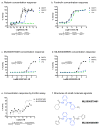Identification of small-molecule agonists of human relaxin family receptor 1 (RXFP1) by using a homogenous cell-based cAMP assay
- PMID: 23212924
- PMCID: PMC4804196
- DOI: 10.1177/1087057112469406
Identification of small-molecule agonists of human relaxin family receptor 1 (RXFP1) by using a homogenous cell-based cAMP assay
Abstract
The relaxin hormone is involved in a variety of biological functions, including female reproduction and parturition, as well as regulation of cardiovascular, renal, pulmonary, and hepatic functions. It regulates extracellular matrix remodeling, cell invasiveness, proliferation, differentiation, and overall tissue homeostasis. The G protein-coupled receptor (GPCR) relaxin family receptor 1 (RXFP1) is a cognate relaxin receptor that mainly signals through cyclic AMP second messenger. Although agonists of the receptor could have a wide range of pharmacologic utility, until now there have been no reported small-molecule agonists for relaxin receptors. Here, we report the development of a quantitative high-throughput platform for an RXFP1 agonist screen based on homogenous cell-based HTRF cyclic AMP (cAMP) assay technology. Two small molecules of similar structure were independently identified from a screen of more than 365 677 compounds. Neither compound showed activity in a counterscreen with HEK293T cells transfected with an unrelated GPCR vasopressin 1b receptor. These small-molecule agonists also demonstrated selectivity against the RXFP2 receptor, providing a basis for future medicinal chemistry optimization of selective relaxin receptor agonists.
Keywords: GPCR; RXFP1; agonist; qHTS; relaxin; small molecule.
Conflict of interest statement
The authors declared no potential conflicts of interest with respect to the research, authorship, and/or publication of this article.
Figures



Similar articles
-
Identification and optimization of small-molecule agonists of the human relaxin hormone receptor RXFP1.Nat Commun. 2013;4:1953. doi: 10.1038/ncomms2953. Nat Commun. 2013. PMID: 23764525 Free PMC article.
-
Structural Insights into the Activation of Human Relaxin Family Peptide Receptor 1 by Small-Molecule Agonists.Biochemistry. 2016 Mar 29;55(12):1772-83. doi: 10.1021/acs.biochem.5b01195. Epub 2016 Mar 4. Biochemistry. 2016. PMID: 26866459 Free PMC article.
-
Optimization of the first small-molecule relaxin/insulin-like family peptide receptor (RXFP1) agonists: Activation results in an antifibrotic gene expression profile.Eur J Med Chem. 2018 Aug 5;156:79-92. doi: 10.1016/j.ejmech.2018.06.008. Epub 2018 Jun 7. Eur J Med Chem. 2018. PMID: 30006176 Free PMC article.
-
Targeting the relaxin/insulin-like family peptide receptor 1 and 2 with small molecule compounds.Mol Cell Endocrinol. 2019 May 1;487:40-44. doi: 10.1016/j.mce.2018.12.013. Epub 2018 Dec 24. Mol Cell Endocrinol. 2019. PMID: 30590098 Free PMC article. Review.
-
International Union of Basic and Clinical Pharmacology. XCV. Recent advances in the understanding of the pharmacology and biological roles of relaxin family peptide receptors 1-4, the receptors for relaxin family peptides.Pharmacol Rev. 2015;67(2):389-440. doi: 10.1124/pr.114.009472. Pharmacol Rev. 2015. PMID: 25761609 Free PMC article. Review.
Cited by
-
Identification and optimization of small-molecule agonists of the human relaxin hormone receptor RXFP1.Nat Commun. 2013;4:1953. doi: 10.1038/ncomms2953. Nat Commun. 2013. PMID: 23764525 Free PMC article.
-
Structural Insights into the Activation of Human Relaxin Family Peptide Receptor 1 by Small-Molecule Agonists.Biochemistry. 2016 Mar 29;55(12):1772-83. doi: 10.1021/acs.biochem.5b01195. Epub 2016 Mar 4. Biochemistry. 2016. PMID: 26866459 Free PMC article.
-
Activation of Relaxin Family Receptor 1 from Different Mammalian Species by Relaxin Peptide and Small-Molecule Agonist ML290.Front Endocrinol (Lausanne). 2015 Aug 17;6:128. doi: 10.3389/fendo.2015.00128. eCollection 2015. Front Endocrinol (Lausanne). 2015. PMID: 26347712 Free PMC article.
-
RXFP1 is Targeted by Complement C1q Tumor Necrosis Factor-Related Factor 8 in Brain Cancer.Front Endocrinol (Lausanne). 2015 Aug 13;6:127. doi: 10.3389/fendo.2015.00127. eCollection 2015. Front Endocrinol (Lausanne). 2015. PMID: 26322020 Free PMC article. Review.
-
Multi-Component Mechanism of H2 Relaxin Binding to RXFP1 through NanoBRET Kinetic Analysis.iScience. 2019 Jan 25;11:93-113. doi: 10.1016/j.isci.2018.12.004. Epub 2018 Dec 10. iScience. 2019. PMID: 30594862 Free PMC article.
References
-
- Kong RC, Shilling PJ, Lobb DK, Gooley PR, Bathgate RA. Membrane receptors: structure and function of the relaxin family peptide receptors. Mol Cell Endocrinol. 2010;320(1–2):1–15. - PubMed
-
- Van Der Westhuizen ET, Summers RJ, Halls ML, Bathgate RA, Sexton PM. Relaxin receptors--new drug targets for multiple disease states. Curr Drug Targets. 2007;8(1):91–104. - PubMed
-
- Hsu SY, Nakabayashi K, Nishi S, Kumagai J, Kudo M, Sherwood OD, et al. Activation of orphan receptors by the hormone relaxin. Science. 2002;295(5555):671–4. - PubMed
-
- Halls ML, Bathgate RA, Summers RJ. Relaxin family peptide receptors RXFP1 and RXFP2 modulate cAMP signaling by distinct mechanisms. Mol Pharmacol. 2006;70(1):214–26. - PubMed
-
- Bogatcheva NV, Truong A, Feng S, Engel W, Adham IM, Agoulnik AI. GREAT/LGR8 is the only receptor for insulin-like 3 peptide. Mol Endocrinol. 2003;17(12):2639–46. - PubMed
Publication types
MeSH terms
Substances
Grants and funding
LinkOut - more resources
Full Text Sources
Other Literature Sources
Molecular Biology Databases

